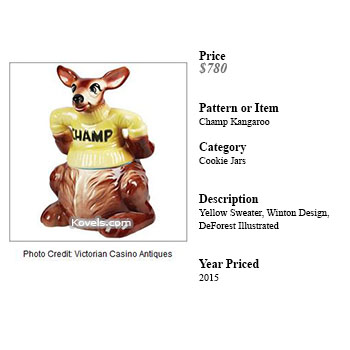Kovels.com has added more than 35,000 prices and 2,500 new photos of priced antiques to our online price guide. All prices are from actual prices at shops, shows, flea markets, auctions, online sales, dealers and other sources. Prices are double-checked for accuracy by Kovels’ experts using their own AccuValue™ system.
The Kovels.com online price guide is organized into more than 750 categories that represent the most popular collecting interests. Category descriptions include information on makers, history, age and marks. This useful information helps accurately price collectibles, identify market trends and serves as a guide for buying, selling, appraising or settling an inheritance. Two generations of Kovels edit the content so the Kovels’ online price guide lists pieces made from the 1680s to as recently as the 1990s.
Listings reflect current interest in midcentury modern furniture, costume jewelry, clothing, glass and ceramics made in the “newest style” between the 1950s and 1990s. Prices for large advertising signs and rock ‘n’ roll posters are up. So are prices for toy cars, mechanical banks, shaving mugs, maps, war and political memorabilia, and anything made of iron, like bookends and doorstops. Down are Hummel and Royal Doulton figurines, “brown furniture,” Roseville pottery and silver tableware that’s not by well-known companies.
You can find almost anything among the Kovels’ added prices and pictures. Rare “treasures” include a sofa made from the tail end of a 1966 Chevy Corvette that auctioned for $604 and 1960s medical model of a human left foot, sold for $295. There was even a c.1820 French provincial dog’s bed with a canopy for $1,722; a patent model of an artificial leg, $1,304; an 1874 corpse cooler and preserver with a viewing window, $3,259; and a pair of wooden tattooed arms used as a trade sign for a tattoo parlor, $300. The highest priced piece is a carved Santa Claus figure made in New York in 1923 that sold for $875,000. The lowest price ($2) was paid for a celluloid dress button with a rhinestone center. Another button ($14) is the smallest item—a glass micro-mosaic button picturing a building. And the largest item is a 150- by 117-inch wood and marble backbar with four columns, mirrors and cast-iron trim that brought $18,000.




Hello, I am having troubles when I log in and go to price guide it kicks me out and won’t let me back in for twenty minutes. This has now happened 5times and it is frustrating. Can you tell me if I am doing something wrong? Or is it a glitch in the system?
Thank you Marianne
I have been unable to get into the online price guide lately. Several years ago I had access to it. What is the problem?